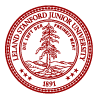Knoll Renovation
 The Knoll was originally built to be the residence of Stanford President Ray Lyman Wilbur, who was elected on October 13, 1915. Architect Louis Christian Mullgardt (1866-1942), envisioned a monumental three-story, Spanish Gothic fortress, with wings extending at obtuse angles, embracing the knoll. In 1946, the building became home to the Stanford University Music Department and in 1986, CCRMA took over residence in this unique building, moving from the former Stanford Artificial Intelligence Laboratory. The Loma Prieta Earthquake in 1989 damaged much of the building, and the third floor was weakened to such an extent that it was deemed unsafe for occupants. For close to fifteen years, The Knoll was never completely reconstructed, and the third floor remained condemned.
The Knoll was originally built to be the residence of Stanford President Ray Lyman Wilbur, who was elected on October 13, 1915. Architect Louis Christian Mullgardt (1866-1942), envisioned a monumental three-story, Spanish Gothic fortress, with wings extending at obtuse angles, embracing the knoll. In 1946, the building became home to the Stanford University Music Department and in 1986, CCRMA took over residence in this unique building, moving from the former Stanford Artificial Intelligence Laboratory. The Loma Prieta Earthquake in 1989 damaged much of the building, and the third floor was weakened to such an extent that it was deemed unsafe for occupants. For close to fifteen years, The Knoll was never completely reconstructed, and the third floor remained condemned.
 A major renovation of the Knoll began in the summer of 2004, and was completed in August of 2005. The renovated Knoll provides state-of-the-art sound studios, a dedicated performance space, and "open-plan'' work areas. Historical aspects of the building were retained and revived through a plan that locates research and studio facilities where they work best and interfere least. The new building permits full-spherical loudspeaker arrangements in the new "Listening Room'', thus enabling new research in synthetic acoustical space. A 100-seat performance hall is located in one wing of the uppermost story to provide a venue specifically intended for contemporary music performance projects. The new hall accommodates larger audiences, allows better scheduling flexibility (reducing contention with classes) and incorporates the building's unique view of the Bay and surrounding hills. The renovation made the building whole and better adapted for teaching and research.
A major renovation of the Knoll began in the summer of 2004, and was completed in August of 2005. The renovated Knoll provides state-of-the-art sound studios, a dedicated performance space, and "open-plan'' work areas. Historical aspects of the building were retained and revived through a plan that locates research and studio facilities where they work best and interfere least. The new building permits full-spherical loudspeaker arrangements in the new "Listening Room'', thus enabling new research in synthetic acoustical space. A 100-seat performance hall is located in one wing of the uppermost story to provide a venue specifically intended for contemporary music performance projects. The new hall accommodates larger audiences, allows better scheduling flexibility (reducing contention with classes) and incorporates the building's unique view of the Bay and surrounding hills. The renovation made the building whole and better adapted for teaching and research.
The University regained a significant landmark with improved public access. A new demo museum lobby incorporated at the entrance provides exhibits pertaining to the history of music technology. Concerts in the renovated Knoll, its historical architectural qualities, and the side-by-side interplay of art and technology are an exciting mix for the future.

